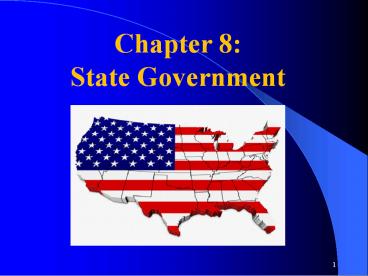Chapter Six, Section Two - PowerPoint PPT Presentation
Title: Chapter Six, Section Two
1
Chapter 8 State Government
1
2
Section 8.1 The Federal System
2
3
The Constitution and Federalism
- A federal system is where the central government
and the states share power. - In a federal system state and federal power is
limited
3
4
The Constitution and Federalism
5
The Constitution and Federalism
- The supremacy clause of the US Constitution says
that the federal law outweighs all state laws.
Which article discusses supremacy? Article ____ - State law must give way to federal law in other
words if a state law contradicts a federal law
the federal law wins.
5
6
States Protection by Constitution
- States are protected by the Constitution in
several ways.
6
7
States Protection by Constitution
- No state can be divided or merged with another
one without its permission.
7
8
States Protection by Constitution
- States have the right to maintain a militia- a
military force called the National Guard. - The governor of a state can call on the National
Guard in local emergencies.
8
9
States Limitations by Constitution
- The US Constitution also identifies what state
governments are not allowed to do.
9
10
States Limitations by Constitution
- States are forbidden to
- 1. Make treaties with foreign nations
- 2. Declare war
- 3. Keep an army or navy in peacetime
- 4. Issue, or coin, their own money
- 5. Impose taxes on imports
Which level of government does have the power to
do these things?
10
11
Reserved Powers
- The Tenth Amendment says that powers not listed
in the US Constitution are reserved for the
states. - These powers are called reserved powers.
11
12
Reserved Powers
- Each state is responsible for the public health,
safety, and welfare of its citizens. - States organize local governments for counties,
cities, and towns.
12
13
13
14
Federal Supremacy
- Concurrent powers are shared by state and federal
governments. - For example, both may impose taxes and borrow
money.
14
15
Governmental Cooperation
Both state and federal governments fund a variety
of programs. Usually the federal government
provides grants-in-aid (awards for money) to the
states to help them pay for some of their
programs.
15
16
Governmental Cooperation
- States must follow rules set by Congress in
order to receive these grants. - For example, the federal government contributes
90 percent of the money to build interstate
highways, but states must comply with federal
regulations, such as width of driving lanes.
16
17
State Constitutions
- States have different constitutions because of
their different beliefs about government. - State constitutions are similar because they all
have separation of powers between executive,
legislative, and judicial.
17
18
State Constitutions
States constitutions also have their own Bill of
Rights . They included most of the Bill of
Rights of the U.S. Constitution and others such
as workers right to join unions.
18
19
Florida Constitution
- Floridas Bill of Rights are found in Article 1
and are referred to as Declaration of Rights. - Some rights include religious freedom, freedom of
speech and press, the right to bear arms, right
to work, protection from imprisonment for debt,
and the rights of the accused and of victims.
19
20
Laws that Promote the Common Good
- "Laws that promote the common good"- laws are
created to protect citizens and
their communities.
20
21
State Constitutions
- State constitutions also establish different
types of local governments, including counties,
townships, and municipalities. - States also can establish independent state
agencies, boards, and commissions such as boards
of education.
21
22
Venn Diagram ActivityOrganize the Following
into State Government, Federal Government, or Both
- The power to enact and enforce laws
- The power to declare war
- The lengthier Constitution of the two and has a
greater impact on the lives of citizens daily - Contains the supremacy clause
- Addresses public education, motor vehicles and
elections - Has only twenty-seven amendments.
- The power to establish courts
- The power to protect the publics health,
welfare, and morals - The power to provide an army and a navy
- The power to administer elections
- The power to levy taxes
- The power to establish local government systems
Concurrent Powers
State Government
National Government
22

